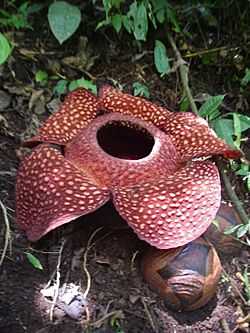Rafflesia facts for kids
Quick facts for kids Rafflesia |
|
|---|---|
 |
|
| Rafflesia arnoldii flower and bud | |
| Scientific classification | |
| Kingdom: | |
| Division: | |
| Class: | |
| Order: | |
| Family: | |
| Genus: |
Rafflesia
|
Rafflesia is a special kind of flowering plant. You can find these amazing plants in Southeast Asia, in places like the Malay Peninsula, Borneo, Sumatra, Thailand, and the Philippines. They are famous for having the biggest single flowers in the world! Some of their flowers can grow to be more than a meter (about three feet) wide.
These huge flowers have a very unique smell. They smell like a dead animal, which might sound gross, but it's actually a clever trick! This smell attracts flies. The flies, which usually lay their eggs on rotting meat, help the Rafflesia pollinate when they crawl inside the flower.
Rafflesia is a parasite. This means it lives off another plant and doesn't make its own food using chlorophyll (like most plants do). It doesn't have a stem, leaves, or even true roots. Instead, it lives inside vines called Tetrastigma, which are related to grapevines. The Rafflesia spreads its special feeding parts, called haustoria, deep inside the vine's tissues. The only part of the Rafflesia plant you can see outside the host vine is its incredible flower!
Contents
How Rafflesia Lives and Grows
Rafflesia plants are known as holoparasites. This means they completely depend on their host plants for all their food and water. Their hosts are always lianas (woody vines) from the genus Tetrastigma. These vines are part of the Vitaceae family, which is the same family as grapevines. So, in a way, Rafflesia is a "parasite of a parasite," because Tetrastigma vines also rely on trees to climb up and reach sunlight.
Each type of Rafflesia usually grows on only one to three specific kinds of Tetrastigma vines. Out of 57 known Tetrastigma species, only about ten are known to be host plants for Rafflesia. For example, one Tetrastigma species called T. tuberculatum is a host for at least 15 different Rafflesia species! Some Rafflesia flowers grow from the vine itself, while others, like R. zollingeriana, always bud from the roots and appear from the ground.
Rafflesia Life Cycle and Reproduction
The number of male and female Rafflesia flowers can be quite different. For example, in R. lobata, there are often about nine male flowers for every female flower. It's rare to find both male and female flowers blooming in the same spot at the same time. This makes pollination and sexual reproduction a bit tricky. However, female flowers often produce fruit anyway, which means they might be able to make seeds without needing pollen from a male flower. Rafflesia plants can keep flowering at the same locations for many decades.
Flies are very important for Rafflesia pollination. For instance, the flowers of Rafflesia arnoldii are visited by flies like Drosophila colorata and Chrysomya megacephala. Sometimes, black ants of the genus Euprenolepis might eat the developing flower buds, which can stop them from growing.
Some animals also interact with Rafflesia flowers. The Javan treeshrew (Tupaia javanica) and the porcupine (Hystrix javanica) are known to eat the flowers. Other mammals, like wild pigs (Sus scrofa), wild cats (Felis bengalensis), and deer, have been seen accidentally destroying buds or flowers by stepping on them.
How People Use Rafflesia
In Thailand, the buds and flowers of R. kerrii are sometimes eaten as a special treat. They are also collected for herbal medicine. People believe a special mix made from them can help with fevers or backaches. In the Philippines, these plants are also used in traditional medicine, and sometimes the flowers are even fed to pigs. On the island of Java, the buds of R. zollingeriana are harvested and dried to be used in jamu, which is a very old traditional herbal medicine system.
Rafflesia plants also help local economies by attracting ecotourists. Many people want to see these giant, unique flowers in their natural habitat.
Scientists in Malaysia and Indonesia have been working to grow Rafflesia plants in special gardens. The famous Bogor Botanical Garden managed to grow the first plants in the 1850s by using parts of infected vines. Around the year 2000, a Malaysian biologist named Jamili Nais was the first person to successfully grow Rafflesia plants from their seeds.
Images for kids
-
Three Rafflesia pricei flowers growing close together near Mount Kinabalu, Borneo.
See also
 In Spanish: Rafflesia para niños
In Spanish: Rafflesia para niños






